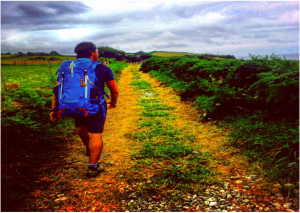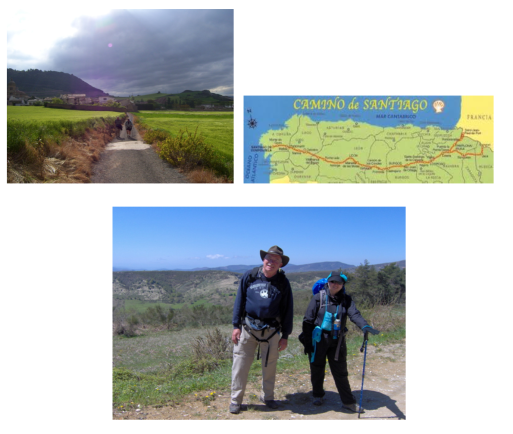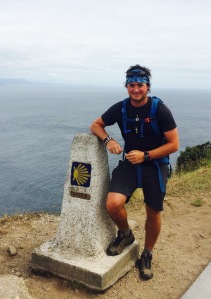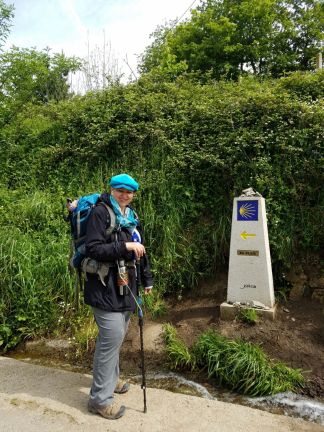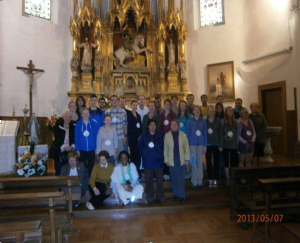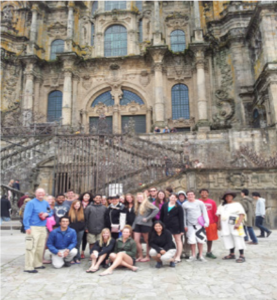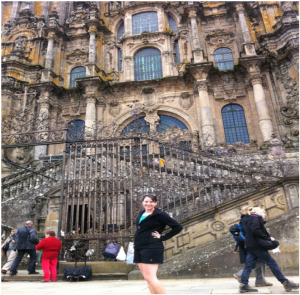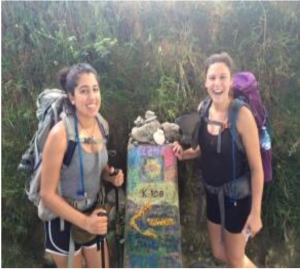EL CAMINO DE SANTIAGO, THE WAY OF ST JAMES
Faculty/Staff Leaders: Deyanira Ariza-Velasco, Matt Baker and Emily Rains
¡Buen Camino!
El Camino de Santiago de Compostela (in English: The Way of St. James) is a network of routes across Spain and Europe which all lead to Santiago de Compostela, in the northwest of Spain. More than a thousand years ago, a spot called the Field of Starts (Campus Stellae) was identified as the last resting place of the Apostle Saint James. It soon became a place of worship, destination for millions of Medieval pilgrims. Three different routes, two through the interior and one hugging the cost, converged of Medieval Christendom, Santiago de Compostela.
Nowadays, tens of thousands walk or cycle the Camino de Santiago every year in an epic journey of 500 miles. People from all over the world with all kinds of motivations: academic approach, sport, culture, religion, nature, adventure etc., travel El Camino de Santiago, or parts of it, in a lifetime experience. El Camino de Santiago has been declared World Heritage by UNESCO and the First European Cultural Itinerary.
ROUTES
The main routes of El Camino de Santiago – The Way of St. James are:
*The French Way (in Spanish: Camino de Santiago Frances) which goes from the French side of the Pyrenees through the interior of northern Spain as far as Santiago de Compostela, in the Spanish region of Galicia. It’s the most famous and followed route of El Camino de Santiago.
Interdisciplinary courses haven offered at Westminster College in 2007, 2010, 2013 and 2016. The topics have been confined from Spanish culture to History, Mathematics, and Anthropology. Students have made films as following
Click here to see the Video: https://docs.google.com/file/d/0B_CBNfaEIuEWWU04c0pTOGpES2s/edit?pli=1
* The Northern Way (in Spanish: Camino de Santiago del Norte) which from the Basque Country follows the northern coast of Spain and the mountains of Asturias until Santiago. It has breathtaking landscapes and it’s less crowded.
We focus especially on the French Way and also on the Northern Way because they are the most popular and they are the ones we are going to walk for 2016. The following video by Zachary Lindahl was his part of his Internship and Direct Study project at the Spanish Department:
Click here to see the Video: https://www.youtube.com/watch?v=Ik82DU7eAXg&feature=player_embedded
*The Silver Way (Via de la Plata) starts in Seville in Andalusia, southern Spain, and follows an ancient Roman route merging with El Camino Frances in its final part. Click here to see the map
*The Primitive Way or Original Way (Camino de Santiago Primitivo) crossing the high mountains of Asturias. Click here to see the map
*The Portuguese Way (Camino de Santiago Portugues) from the Portuguese city of Porto. This website covers general aspects of planning your pilgrimage along Camino de Santiago. Click here to see the map
HISTORY OF EL CAMINO DE SANTIAGO
El Camino de Santiago came to being due to the belief that the apostle Saint James was buried in the land of Galicia, in the northwest of Spain. Saint James spent some years preaching the Gospels in the Iberian Peninsula, and in fact he is the patron saint of Spain. After his return to Jerusalem he was beheaded by King Herod Agrippa in the year 44 AD, thus becoming one of the first Christian martyrs. Probably at this point, history gives way to legend. Following the saint’s dead, it was said that St. James’ disciples put his body in a stone boat that, lead by angels, sailed across the Mediterranean Sea, went through the Pillars of Hercules in the Strait of Gibraltar to finally arrive at the coast of Galicia, where a massive rock closed around his relics. These were later removed to Compostela.
The name of Compostela comes from the Latin Campus stellae which means field of stars and at the same time has a link to the other name of the Camino de Santiago which is the Milky Way. The reason for this is because when walking el Camino de Santiago at night you can see our galaxy the Milky Way directly over you. In other words, you are walking from East to West in the same direction as the Milky Way. Again, while walking in the daylight, the pilgrims also follow another star, the Sun, as it crosses from east to west. It is therefore difficult to say whether el Camino took its name from the galaxy or vice versa.
Hence, it wasn’t necessary to invent el Camino de Santiago as a material thing, as a road infrastructure since old routes already crossed by many groups and civilizations could be used. Since pre-roman times, these routes already communicated the river Ebro’s valley and the Mediterranean Sea through the Meseta Norte (northern high planes) with Iberia’s northwest and Atlantic Ocean. In fact, the Romans had important routes that were the core for the new network of Caminos de Santiago.
The first pilgrimages date back to the 9th and 10th centuries. However, the conditions for the development of a pilgrimage way weren’t good at that time. Firstly, because of the insecurity of the roads and secondly because the majority of Iberia was under the rule of Cordoba’s caliph. Iberia was at that time Muslim and the Christians, relegated to the mountains in the north, were in constant battle and struggle for their survival.
The strengthening of El Camino de Santiago took place in the 11th century. In a way, this fact had to do with the general European expansion during this century. The peace was recovered in the roads and the number of people who travelled along these roads for many different motivations increased sharply.
El Camino de Santiago had many protectors both in the Spanish territory and in other European kingdoms…click here for more information http://www.caminosantiagodecompostela.com/el-camino-de-santiago-history/
Click here to see Video: https://www.youtube.com/watch?v=HgCOQDl7FTE
FOLLOWING THE YELLOW ARROWS:
The name of Don Elías Valiña Sampedro might not ring any bells but you will certainly recognize his most ‘famous’ creation: the yellow arrow pointing the way along the Camino de Santiago.
Don Elías (1929-1989) was the parish priest in O Cebreiro in Lugo and studied the history of the St James Way pilgrimage to Santiago in depth, writing many documents, articles and even a thesis on the Camino de Santiago for the University of Salamanca.
Don Elías was a bit of visionary and a Camino ‘pioneer’: after years studying the St James Way, he was convinced of the importance of this ancient trail and set himself the challenge of reviving the route we call the French Way. In 1984, he put in motion his mission to rescue, clean and mark the trails along Camino, starting in Roncesvalles, in the Pyrenees. He also started painting the iconic yellow arrows to indicate the right way at the various tricky crossroads along the trail. Legend has it that Don Elías drove across the whole north of Spain on his Citroën GS packed with yellow paint, painting arrows leading to Santiago.
He also promoted the creation groups and associations to revive and maintain the different stretches of the Camino; and traveled to other European universities and conferences to explain the importance of the Camino de Santiago as a space of communication and understanding for people of many nationalities. So today’s walkers owe much more to Don Elías than just the yellow arrows helping them find their way, in fact.
We probably owe him the fact that the Camino is still in existence at all!Along with the famous scallop shell, yellow arrows painted on trees, pavement, buildings, etc… mark the route for thousands of pilgrims walking to Santiago de Compostela every year. Walking and following the yellow arrows should be enough to get you to Santiago. Back in the 80s, when encountered by curious bystanders (and even the police!) Don Elías would explain he was ‘planning an invasion’.
Since he died in 1989, he didn’t get to see his vision for an ‘invasion’ fully accomplished but we are sure he would be pleased to see the Camino today and would rejoice at the view of thousands of pilgrims of all ages and nationalities following his yellow arrows to Santiago every year.
Modern shell
An universally identified symbol on the pilgrim’s route. This is the latest version of the scallop shell, represents schematic yellow scallop shell on blue (colors of the European Union) displayed on information boards, buildings, mile posts to help the orientation
LAS CONCHAS: VIEIRA
The scallop shell is one of the most iconic symbols of the Camino de Santiago and today it is used, along with the yellow arrow, to guide pilgrims heading to Santiago de Compostela along its many different routes. Painted on trees, sidewalks, tiles, etc… the scallop shell (or ‘Vieira’ in Galician and Spanish) will help travelers find their way. There are many stories, legends and myths trying to explain the ancient link between the scallop shell and the Saint James Way. It is no coincidence that in French the scallop is called Coquille Saint Jacques; while in German scallops are called ‘Jakobsmuscheln’ (James mussels)
The scallop shell is said to be a metaphor, its lines representing the different routes pilgrims travel from all over the world, all walking trails leading to one point: the tomb of Saint James in Santiago de Compostela. However, it is open to interpretation. Which side points to Santiago? In some regions, the scallop’s longest line is considered the one pointing towards Santiago. This is the case in Asturias, for example if you are walking the Original Way or the Northern Way, and some parts of the Portuguese Way.
But don’t let this fact confuse you, take the scallop shell as a symbol of the Camino, reassuring you you are on the right path! The scallops are most of the time placed next to a yellow arrow so always follow the arrows (no confusion here!), as they are the most accurate ‘road signs’ to follow.
Medieval pilgrims often wore a scallop shell attached to their cloaks or hats during their journey to Santiago. More than being just a symbol or a pilgrim badge, the scallop shells also had a practical purpose: they were a handy and light replacement for a bowl so the pilgrims could use them to hold their food and drink on their long journey. Pilgrims would also be given food at churches and other establishments, and a scallop shell scoop was the measure for the food they would be donated.
Since the scallop is native to the coast of Galicia, the shell also became a memento, a physical proof of having completed the pilgrimage to Santiago (and quite often walked to or via Fisterra or Finesterra, on the Costa da Morte). The shells could be picked up at the very end of the journey in Fisterra but also became a popular souvenir and source of business for the shops near the Cathedral in Santiago and other establishments along the way.
There are many legends trying to source this old association of Saint James with the scallop shell: one of those legends says the apostle once rescued a knight covered in scallop shells, while a similar version of the same story explains that a knight’s horse fell into the water and emerged covered in scallop shells, while the remains of Saint James were being taken from Jerusalem to Galicia.
There are also many stories about the scallop shell believed to have a much earlier origin, dating to pre-Christian times. It is understood the Camino de Santiago had also become a kind of fertility pilgrimage, taken by couples in need of help to have children. This could be related to the fact that the scallop shell might have been a pagan symbol of fertility, originally.
The shape of the scallop shell also resembles the setting sun, which would have been an important daily event, full of symbolism in pre-Christian societies. It is probably not just a mere coincidence that the Saint James Way is a journey to the West, finishing at the ‘end of the world’ (the name given to Fisterra – Finis Terrae) and the setting sun.
The May Term Study Experiences in 2013: My slow Journey
By Dr. Deyanira Ariza-Velasco
The first question was: “Why walk El Camino [The Way] to Santiago de Compostela?” Of course, some might have needed credits in Spanish or Math, or were required to complete an interdisciplinary and intercultural experience. But, very soon our 20 students, 2 alumni, my colleague Bill Bynum, his wife Clarence, and I understood that the reasons were varied, including personal, cultural, physical and religious, but all with a common denominator: the willingness to experience some kind of service learning through a historical and legendary Camino of pilgrimages and the notion of slow travel. We took the most popular of the nine Caminos that led to the sacred city of Santiago de Compostela: El Camino Frances, which starts by the French village in the Pyrenees: Saint Jane Pied de Port. By May 12, we had already walked 80 kilometers into Spanish territory, from Roncesvalles to Burgos (Navarra, La Rioja, the most famous wine-producing region of Spain, and Castilla) with some segments by bus. Starting here, the Camino was only by foot. The first blisters appeared, along with our first intense experiences of fatigue, however, those were compensated by the beauty of the landscapes, the variety of art (Romanic, Gothic, Baroque, Mudejar) and the meaning of slow travel.
We walked through valleys, mountains, forests, plains; ahead were more natural beauties, rivers, stunning cathedrals, great urban architecture, fine museums, marvelous food, the great City of Santiago de Compostela, the incredible port city of La Coruña, extraordinary local people, other fellow pilgrims, and 250 kilometers! In the middle of our journey, memory and climate change coincided at the highest point of El Camino de Santiago in Galicia: O Cebreiro. Here, an unpredictable snow blizzard covered our Camino to the most beautiful, historical Medieval village in
El Camino de Santiago. Celtic music, the legend of the Holy Grail and the drastic and rapid change of temperature tested our resolve and pushed us to continue as pilgrims. That night, in a cozy albergue (a refugee for pilgrims) in the Galician village of Fonfria, we were proud of our bravery and willingness to be involved in this unique experience; one lived by many pilgrims throughout many centuries. We were one group with an extraordinary sense of community, engaged in some kind of service learning, understanding the real meaning of sustainability and slow travel. Bill lectured how Math offers us the opportunity to understand the order of life for pilgrims; I could, finally, offer an authentic and historical sense of being a real pilgrim in the Camino; and the students could respond in their dual journals (for Math and for Spanish) using reflexive and critical thinking about their experiences, their learning based on a lens of a real and hard journey, and the order and orientation of the Camino. Finally, arriving in the city of Santiago de Compostela we each obtained our Compostela, a certificate of accomplishment. We considered the experience great adventure, even a spiritual adventure, to remove ourselves from the bustle of modern life. We keep our memories and concluded that doing the Camino is the experience of a lifetime and we will be forever united, regardless of origin or language, by the universal pilgrim greeting: Buen Camino!
MTSE Leaders:
Bill Bynum & Deyanira Ariza-Velasco
WHY THE CAMINO? Students say…:
For Alicia Foster, the Camino de Santiago in 2013 was the life-journey of her life; it was a route of true happiness. She graduated from Westminster in May 2015 and today is living in Spain perusing her future. One storming day in the Camino, after the beautiful and medieval town of O’Cebreiro, Galicia, she met her loved Eduardo, a Galician and extraordinary man. The camino has been for her a transforming destiny.
For Erika Collins, the Camino de Santiago in the summer 2015 was not only part of her Direct Studies and the theme of her Thesis for graduation in the Spanish and Latin American Studies program but also the best part of her life. In her journal she wrote: “I feel like these are the best days of my life. I refuse to let these memories go, I will hold on to them forever”. Her thesis explores the relationship between journaling, guides and the Camino de Santiago, it could be found here
For Zachary Lindahl the Camino de Santiago has been the authentic buen camino. The Camino by the North route and the French route in the summer 2015 was not only part of his Intensive Internship serving as hospitalero, a Direct Study for his academic credits into the program of Spanish and Latin American Studies but also the experience of his entire life, a transformation and a discovery. He will continue to do the camino in the future because he would like to share, and remind others that still there is kindness and love in the world. His interdisciplinary study in Spanish and Geology has found a new vision in the Camino de Santiago. His transformative point of view for his life and his academic performance could be read in his journal here.
DOCUMENTALS
To see DOCUMENTALS about the Camino de Santiago 2015,
https://www.youtube.com/watch?v=f4R30r6Tync
https://www.youtube.com/watch?v=XrsVEE6RF2g
IMPORTANT LINKS
http://www.americanpilgrims.com


